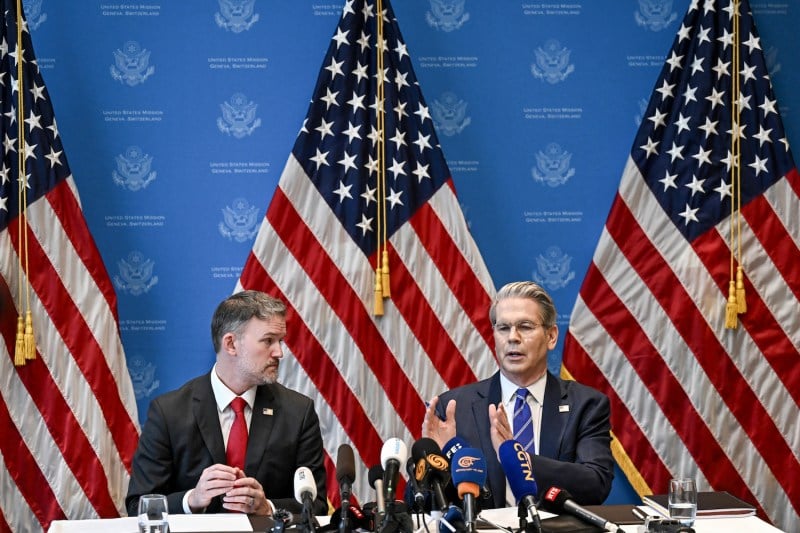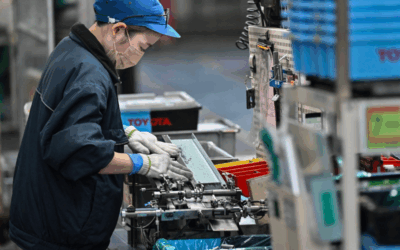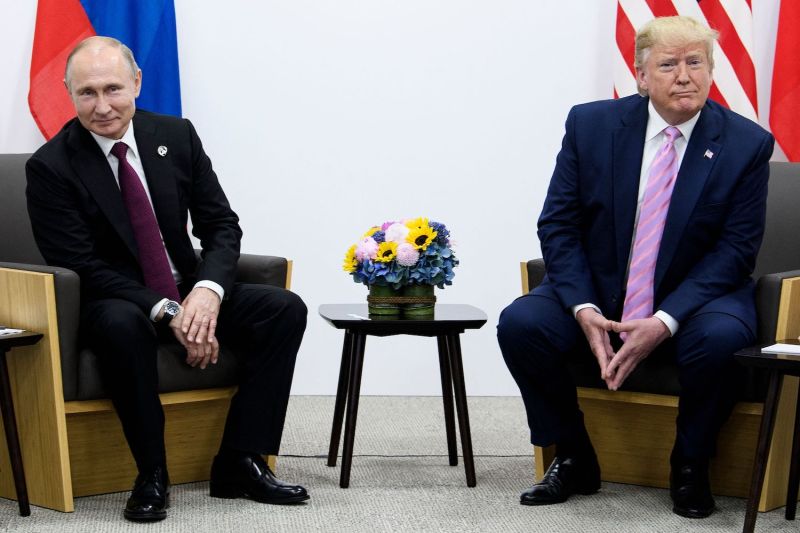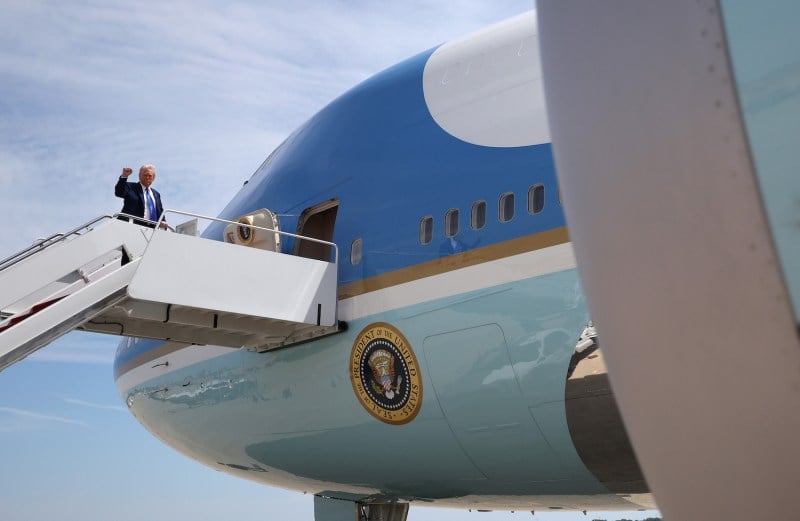U.S. and China Announce Big Tariff Rollback

U.S. and China Announce Big Tariff Rollback
In a joint statement, the two sides took a step back from the cliff.
U.S. Treasury Secretary Scott Bessent (right) and U.S. Trade Representative Jamieson Greer hold a news conference in Geneva on May 12. Fabrice Coffrini/AFP via Getty Images
Trade talks between the United States and China in Geneva this weekend yielded a surprisingly significant announcement: Both countries agreed to drop their tariffs on each other by 115 percentage points, bringing U.S. tariffs on Chinese imports to 30 percent and China’s tariffs on U.S. imports to 10 percent.
“There was very good personal interaction. Both countries represented their national interests very well. We concluded that we have shared interests and we both have an interest in balanced trade,” said U.S. Treasury Secretary Scott Bessent during a press conference Monday morning in Geneva.
Trade talks between the United States and China in Geneva this weekend yielded a surprisingly significant announcement: Both countries agreed to drop their tariffs on each other by 115 percentage points, bringing U.S. tariffs on Chinese imports to 30 percent and China’s tariffs on U.S. imports to 10 percent.
“There was very good personal interaction. Both countries represented their national interests very well. We concluded that we have shared interests and we both have an interest in balanced trade,” said U.S. Treasury Secretary Scott Bessent during a press conference Monday morning in Geneva.
Stocks jumped on the news, with the S&P 500 and Hong Kong’s Hang Seng index both rising nearly 3 percent.
The agreement is set to last for 90 days. That mirrors the negotiating timeline that the Trump administration has granted the dozens of other countries hit with high “reciprocal tariff” rates during President Donald Trump’s “Liberation Day” trade announcement on April 2. China committed to dropping the slew of non-tariff retaliatory measures it had imposed on the United States since April 2, and the two countries also agreed to set up a mechanism for the next round of negotiations.
What’s striking is how quickly the United States and China were able to hammer out this initial deal—even faster than the breakneck escalation that saw the United States jack up tariffs on China three times within one week in April.
Bessent and Chinese Vice Premier He Lifeng met on Saturday and Sunday and emerged Monday morning with the agreement in the form of a joint statement. That’s notable because with the souring of U.S.-China relations, the two sides only produced joint statements on climate change during the Biden administration. Otherwise, each side produced its own independent readouts from meetings.
The quick turnaround shows that China is willing to match Trump’s tempo. “The rapid nature that we were able to conduct and conclude these negotiations is a testament to mutual understanding and mutual respect between the Chinese and U.S. sides,” said U.S. Trade Representative Jamieson Greer, who also attended the talks.
It also signals that the tariffs were starting to bite in both countries. China’s shipments to the United States dropped 21 percent in April, major corporations including toymaker Mattel announced they would be raising prices, U.S. farmers were scrambling to find a new home for their agricultural exports to China, and the United States was facing a looming rare-earth element blockade from China.
Chinese officials struck an upbeat tone coming out of the talks. “The meeting has yielded substantial progress, significantly reducing bilateral tariffs. … It is hoped that the U.S. side will continue to work with China, move in the same direction, and fully rectify its erroneous practice of imposing unilateral tariffs,” the Chinese Ministry of Commerce said in a statement. Chinese state media claimed the outcome as a victory for China. “This demonstrates that China’s firm countermeasures and resolute stance have achieved very positive results,” wrote Yuyuan Tantian, a social media account affiliated with the state-owned China Media Group.
The Trump team also claimed success on Monday, calling the deal a “historic trade win.” But the outcome raises fresh questions about the logic of Trump’s trade strategy. Wendy Cutler, vice president at the Asia Society Policy Institute and a former senior U.S. trade negotiator, said that the rapid escalation of tariffs in early April likely had the effect of bringing the two sides to the negotiating table sooner. But beyond that, it’s unclear what the United States gained.
Going forward, if tariffs stay low, then Trump won’t bring in the billions of dollars he promised from taxing importers or protect domestic manufacturers as fully. Meanwhile, over the last month, international trade flows have been scrambled and markets have gone through a wild ride.
The true test of the Trump trade strategy will be the forthcoming deeper negotiations, to be led by Bessent, Greer, and, on the Chinese side, He.
“This is a truce, not a treaty. Both sides are signaling flexibility, but neither is backing away from rivalry. The next 90 days will tell us if this becomes a pathway to stability or just a pause before the next punch,” said Craig Singleton, a senior China fellow at the nonpartisan Foundation for Defense of Democracies, in a statement.
Substantial issues between the United States and China remain, from fentanyl to overcapacity leading to record exports from China. “My view is, once the euphoria dies down a bit, and we’re in the trenches trying to deal with these issues, things can get complicated pretty quickly,” Cutler said.
This post is part of FP’s ongoing coverage of the Trump administration. Follow along here.
Lili Pike is a reporter at Foreign Policy. X: @lili_pike
More from Foreign Policy
-

Eight people dressed in camouflage military combat uniforms wade across a river, the water up to their waists. The soldiers carry large backpacks along with their rifles. Snowcapped mountains and a thick forest of evergreen trees loom in the distance. Get Ready for the Aleutian Island Crisis
As conflict heats up in the Arctic, foreign adversaries eye Alaskan territory.
-

U.S. President Donald Trump speaks to reporters before boarding Air Force One at Morristown Municipal Airport in Morristown, New Jersey, on April 27. Trump’s First 100 Days Reveal a ‘Strongman’s’ Unprecedented Weakness
No U.S. president has ever surrendered global power so quickly.
-

An elderly man and woman sit on the ground, the man on his knees as he sorts through something on the ground. Behind him are a rusted cart and bicycle in front of a paint-smeared concrete wall and a battered corrugated metal sign with the words USAID: From the American people” on it. What Trump’s New Budget Says About U.S. Foreign Policy
The president wants to significantly pull back on many of America’s traditional global engagements while spending more on the border and defense.
-

U.S. President Donald Trump listens to Secretary of State Marco Rubio at a cabinet meeting in the White House in Washington, D.C. Rubio’s Reorganization Plan Is a Wrecking Ball
The State Department revamp goes far beyond streamlining—it will devalue human rights and strip away critical expertise.









Join the Conversation
Commenting on this and other recent articles is just one benefit of a Foreign Policy subscription.
Already a subscriber?
.
Subscribe
Subscribe
View Comments
Join the Conversation
Join the conversation on this and other recent Foreign Policy articles when you subscribe now.
Subscribe
Subscribe
Not your account?
View Comments
Join the Conversation
Please follow our comment guidelines, stay on topic, and be civil, courteous, and respectful of others’ beliefs.
Change your username |
Log out
Change your username:
CANCEL
Confirm your username to get started.
The default username below has been generated using the first name and last initial on your FP subscriber account. Usernames may be updated at any time and must not contain inappropriate or offensive language.